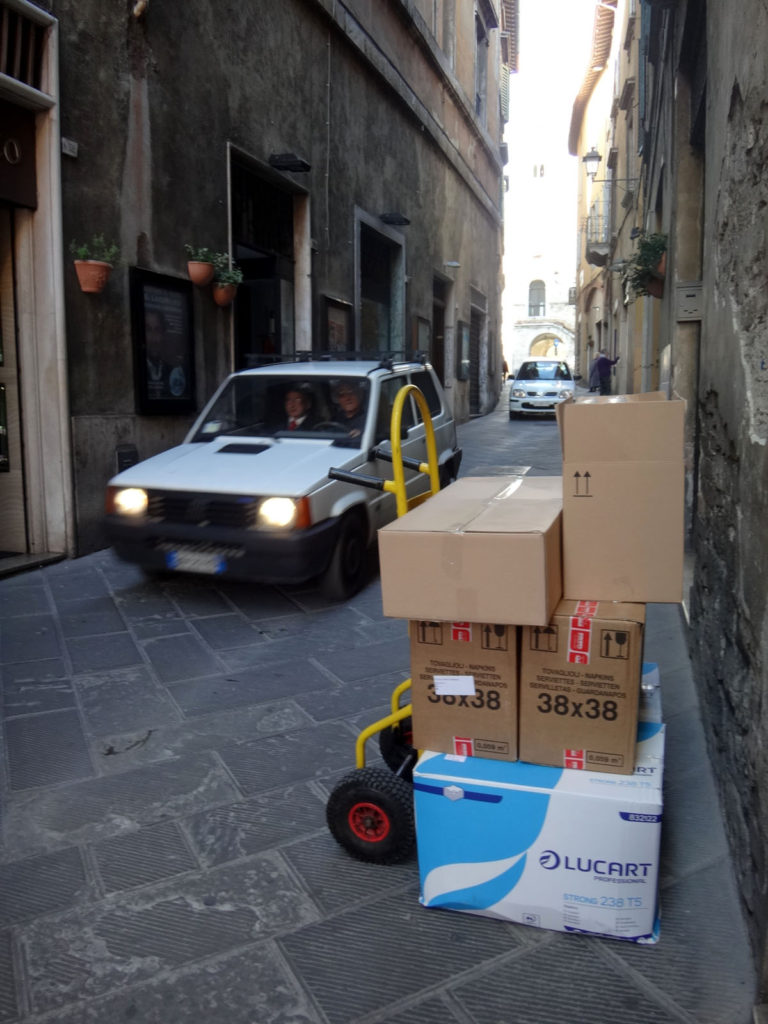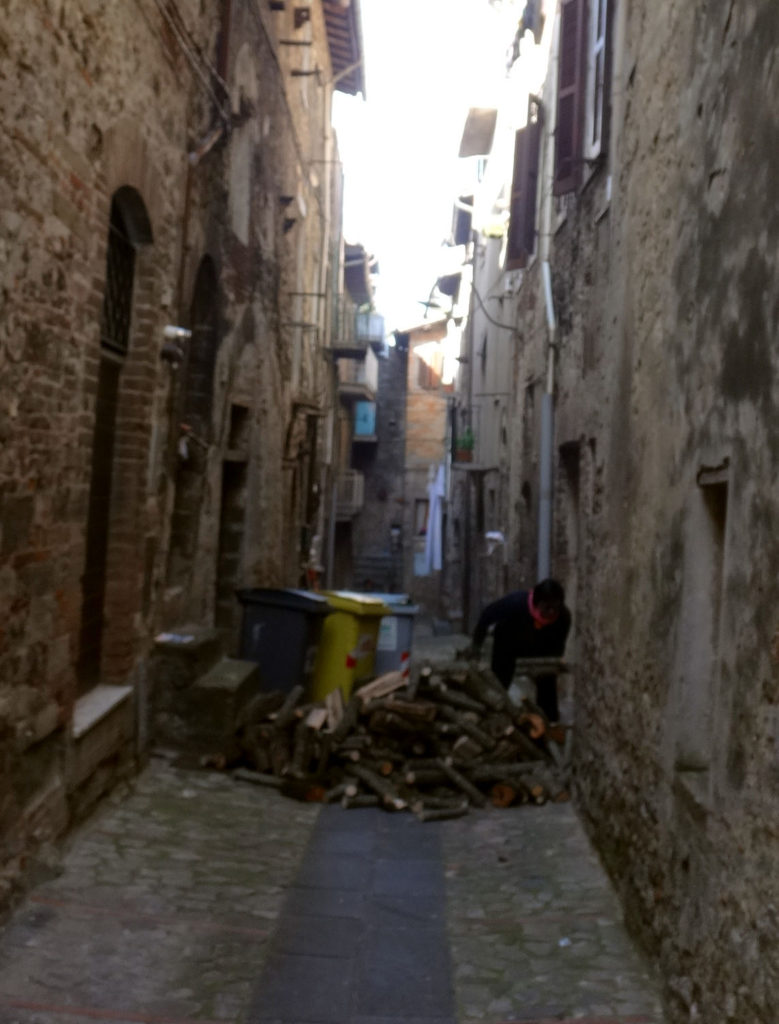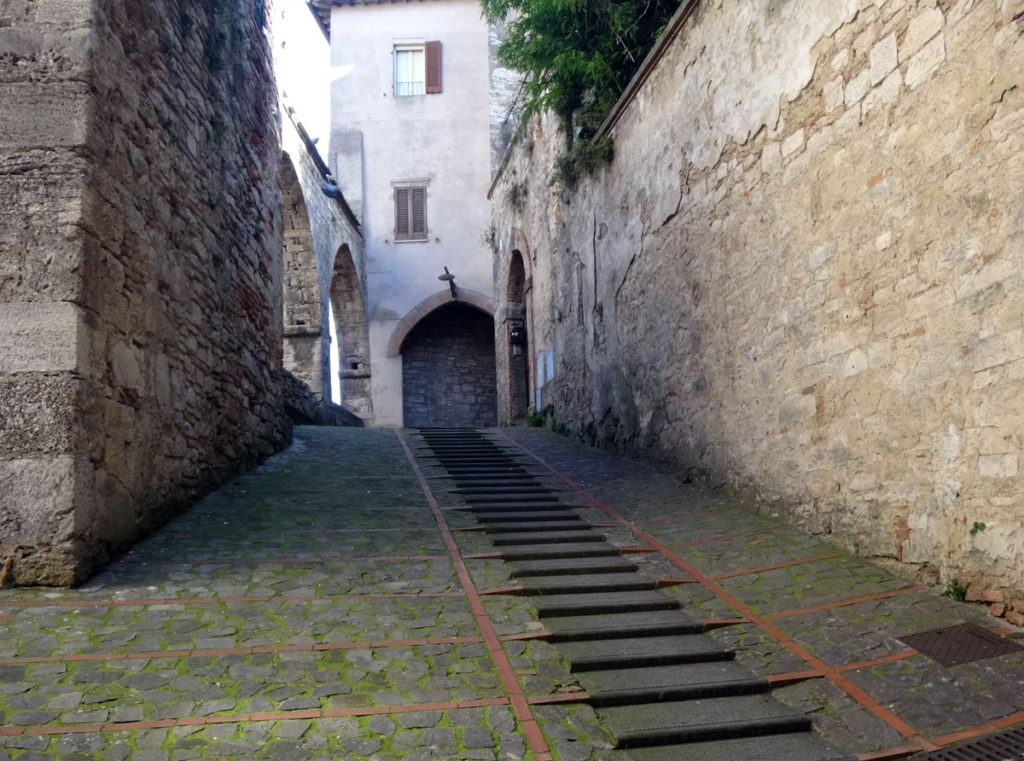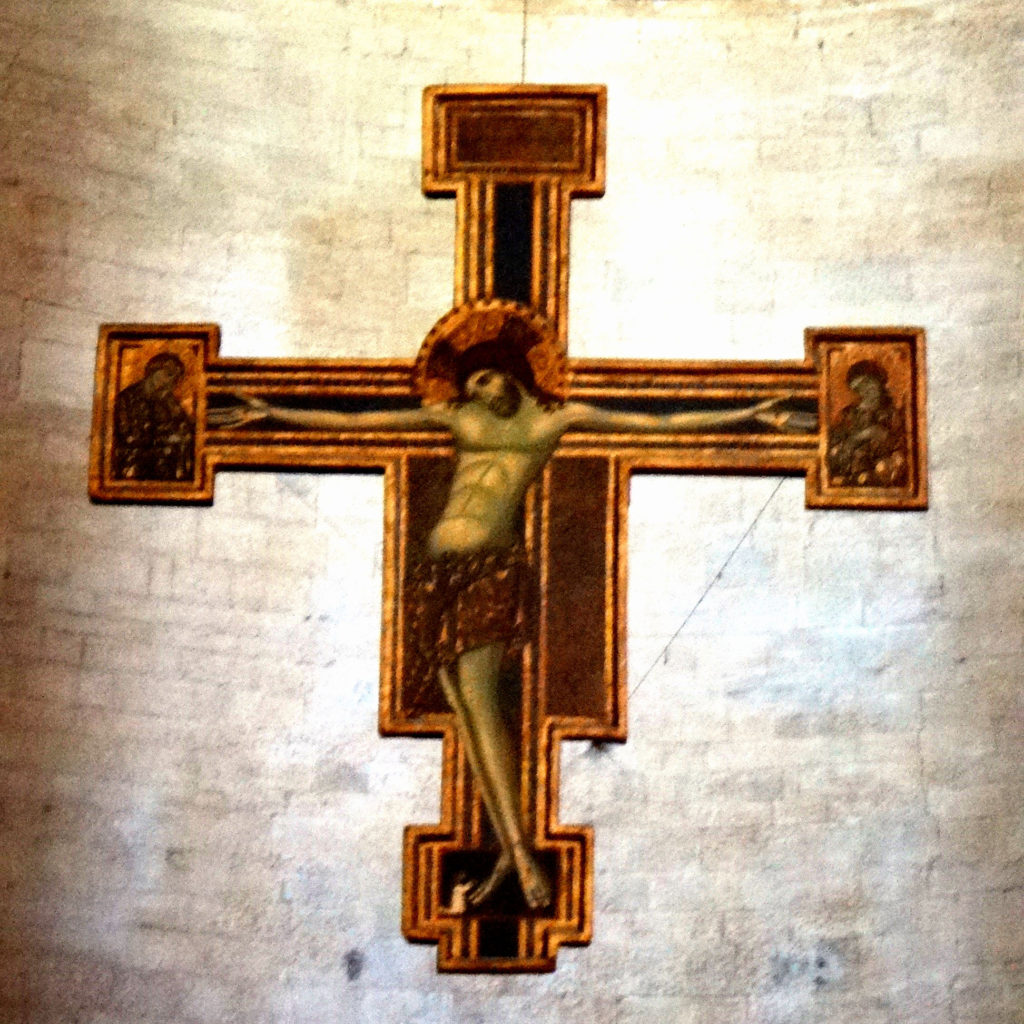Small towns top the hills of Umbria like crowns set upon a rocky brow. Travel authors recommend one little hill town after another but we chose to visit Todi first because it was just 12 kilometers from where we were staying in San Gimignano. Perfect choice! Winding streets, an unusual duomo, rocky walls and a steep climb defined our first hill city. We were smitten.

Todi was founded well before the birth of Christ at the confluence of the Naia and Tiber rivers; it’s about 90 minutes northeast of Rome and 45 minutes south of Perugia.
We actually drove into the city, climbing the hand-laid stone roads and tucking our side mirrors in as the buildings on each side of the street closed in on us.


We should have parked at the top of the steep hill, but we snagged the first parking spot we found in a yellow zone. (Blue-lined parking spots are for residents; yellow-lined parking spots are for visitors but you pay; white-lined parking spots are free.) We took out the little cardboard clock from it’s pocket on the windshield, set the clock to 1:00 to indicate the time of our arrival, purchased a parking ticket from an automated pay booth, stuck that ticket on our dashboard and set off to see the city. The little clock indicated to authorities what time we arrived; if we overstayed our allotted 2 hours, we would have been ticketed even though we paid for several hours. So we knew we had to climb to the top of the hill and return in just under 2 hours.
It was a cool but sunny day in March, so we walked briskly up the steep hill. Whenever we were lost, we just headed uphill. The highest point of each hill town seemed to be the central plaza with a cathedral which was usually where we were headed. To return to our car? We just headed downhill.
The beauty of this small town unfolded as we rounded each corner and continued to climb upwards. I could see why Architecture Professor Richard S. Levine of the University of Kentucky proclaimed Todi to be the model sustainable city. Todi had reinvented itself constantly from its birth as an Umbrian/Etruscan city through its years under seige by Goths and Byzantines to rule under the Popes to a leader in the Risorgimento movement to unify Italy. In the 90’s, the Italian press proclaimed Todi as the most livable city in the world…and it’s nearly 3,000 years old (Todi, 1992)!




Lunch!
We arrived in Todi in time for lunch – and we worked up quite an appetite hiking uphill – but every recommended restaurant was closed in March. In fact, this was our experience in town after town. Restaurants and tourist sites simply were not open during the first two weeks of March.
We were happy to stumble upon a little local shop called Le Roi de la Crepe. Prices were very reasonable, ranging from 5-9 Euros, and the food was fresh and delicious. We were told it’s not acceptable to walk and eat in Italy but with no place to sit, we took our sandwiches and munched as we continued our stroll through Todi.


Town Square – The Piazza Vittorio Emanuele II
“Called Piazza Grande in ancient times, it was probably located on the site of the Roman Forum and was much larger than the square which can be seen today. Counted as one of the most beautiful medieval squares in Italy, it is surrounded by numerous palaces and is dominated by the Cathedral” (Bonechi).



We tried to visit the museum operated by the Diocesi di Orvieto-Todi, but it was closed. The folks were pretty surprised when we took an elevator to the top floor and discovered a cluster of employees chatting away. They tried to figure out how we got into the building as they shooed us back into the elevator and out of the building.
The best part of the Grand Plaza had to be the ice cream! See the little white truck to the right in the square (photo above)? Just beyond that truck was the lovely Bacio di Latte (Milk Kiss) gelateria. Delicious!


Around the corner we discovered a beautiful, towering something. It looked like a false front from a film set. But it was the local branch of the oldest surviving bank in the world, founded in 1472 in Siena, Italy, about 150 km away.

Views from Todi
We could not point our cameras from the hilltop without capturing a beautiful view from Todi. The trees and flowers were just starting to bloom. I imagine the sites are breathtaking later in spring.


The S. Maria dell’Annunziata Cathedral
We huffed and puffed our way to the top of a flight of travertine stairs extending from the Piazza Vittorio Emanuele to reach one of the strangest-looking cathedrals I’ve ever seen. There’s no dome. No arches. No flying buttresses. Just a flat top like the architect said, “OK, I’m done.” More likely donations dried up because of an economic downturn or a war and the parishioners said, “Basta!”

The 13th century bell tower was used for defense but now features bells that call to worship. The beauty spot of the cathedral has to be the double rose window in the center of the church, over the door.
The inside of the duomo is simple with a few artifacts of interest. Faenzone created the Last Judgement fresco under the double rose stained glass window.

Can you see the little putti in each leaf of the rose stained glass window? The Holy Spirit is symbolized by a dove in the center of the window.
There’s a bronze hanging of St. Martin I hanging in the cathedral but I don’t know why. St. Martin was a pope and martyr who died defending the Catholic Church’s right to “establish doctrine in the face of imperial power” (Pope St. Martin I). He died in 656 after a miserable trip by sea from Rome to Constantinople and after being imprisoned, tried and denounced. St. Martin I was the last pope to die for his faith.

Also of interest is a 13th century cross painted in the style of Giunta Pisano (Bonechi, 2011).

There’s a pretty fresco at the front of the duomo but I could not tell who painted it. The painting is sweet with rich reds and oranges that are fading into pastels.



We loved Todi. So much to see and do! This would be a wonderful, romantic get-away-town for anyone to enjoy.

Sources
Bonechi. (2011). Umbria: Complete guide to the monuments, art and traditions of the region. Florence, Italy: Casa Editrice Bonechi.
Pope Saint Martin I. (n.d.). Retrieved from Catholic Online: http://www.catholic.org/saints/saint.php?saint_id=80
“Todi Come una Citta` Sostenibile,” keynote, Inauguration Convocation Academic Year Università della Terza Età, October 1992, Todi, Italy; “Todi Citta del Futuro,” and “Come Todi Puo Divenire Citta Ideale e Modello per il Futuro”, in Il Sole 24 Ore, Milan, Italy, November 28, 1991


